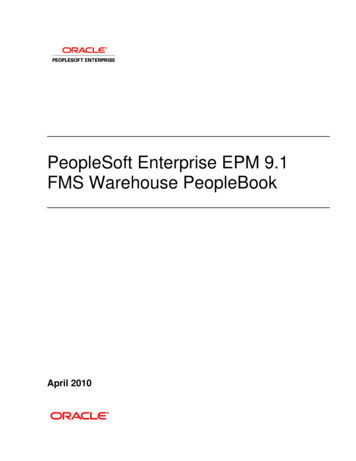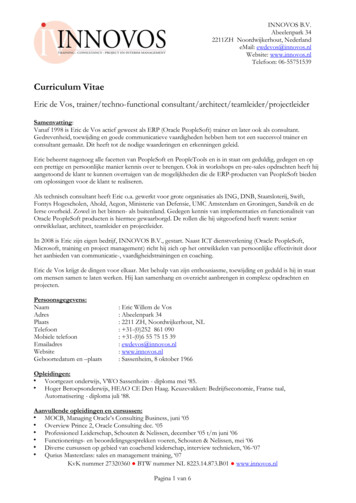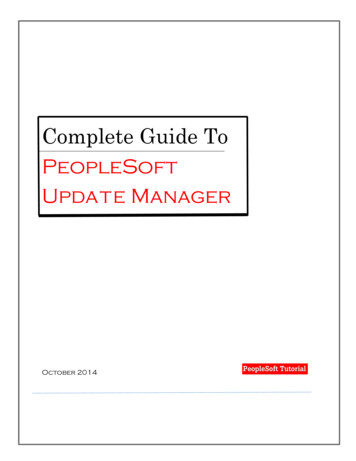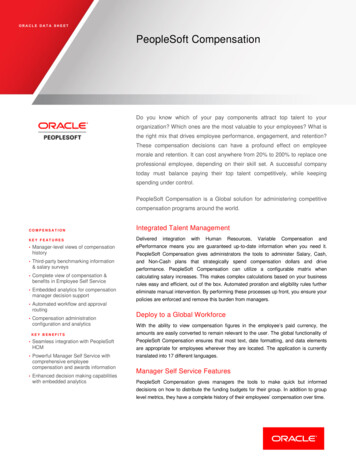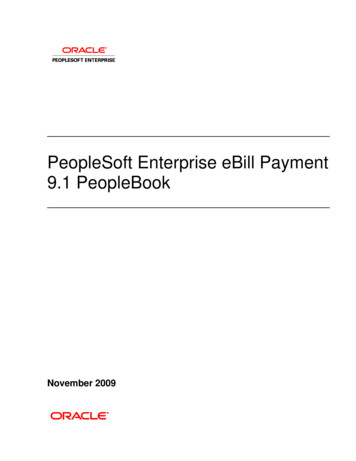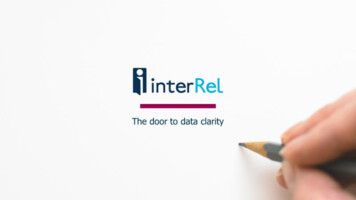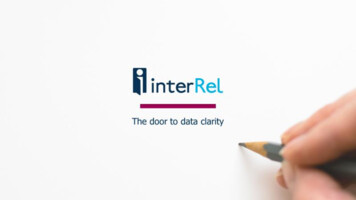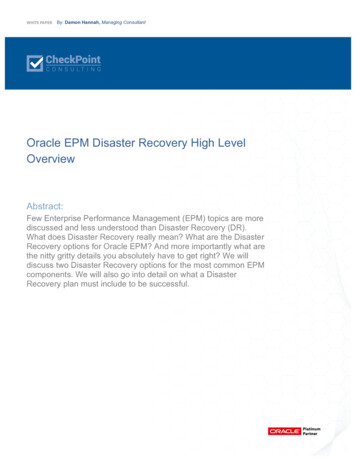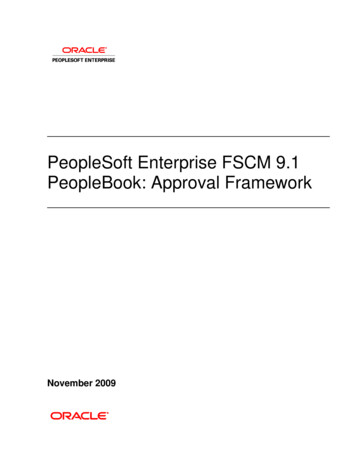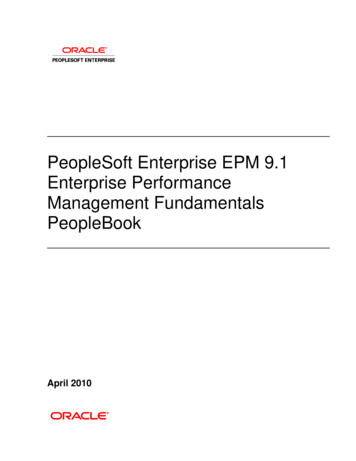
Transcription
PeopleSoft Enterprise EPM 9.1Enterprise PerformanceManagement FundamentalsPeopleBookApril 2010
PeopleSoft Enterprise EPM 9.1 Enterprise Performance Management Fundamentals PeopleBookSKU epm91penw-b0410Copyright 1999, 2010, Oracle and/or its affiliates. All rights reserved.Trademark NoticeOracle is a registered trademark of Oracle Corporation and/or its affiliates. Other names may be trademarks of theirrespective owners.License Restrictions Warranty/Consequential Damages DisclaimerThis software and related documentation are provided under a license agreement containing restrictions on use anddisclosure and are protected by intellectual property laws. Except as expressly permitted in your license agreement orallowed by law, you may not use, copy, reproduce, translate, broadcast, modify, license, transmit, distribute, exhibit,perform, publish or display any part, in any form, or by any means. Reverse engineering, disassembly, or decompilationof this software, unless required by law for interoperability, is prohibited.Warranty DisclaimerThe information contained herein is subject to change without notice and is not warranted to be error-free. If you findany errors, please report them to us in writing.Restricted Rights NoticeIf this software or related documentation is delivered to the U.S. Government or anyone licensing it on behalf of the U.S.Government, the following notice is applicable:U.S. GOVERNMENT RIGHTSPrograms, software, databases, and related documentation and technical data delivered to U.S. Governmentcustomers are "commercial computer software" or "commercial technical data" pursuant to the applicableFederal Acquisition Regulation and agency-specific supplemental regulations. As such, the use, duplication,disclosure, modification, and adaptation shall be subject to the restrictions and license terms set forth in theapplicable Government contract, and, to the extent applicable by the terms of the Government contract, theadditional rights set forth in FAR 52.227-19, Commercial Computer Software License (December 2007).Oracle USA, Inc., 500 Oracle Parkway, Redwood City, CA 94065.Hazardous Applications NoticeThis software is developed for general use in a variety of information management applications. It is not developed orintended for use in any inherently dangerous applications, including applications which may create a risk of personalinjury. If you use this software in dangerous applications, then you shall be responsible to take all appropriate fail-safe,backup, redundancy and other measures to ensure the safe use of this software. Oracle Corporation and its affiliatesdisclaim any liability for any damages caused by use of this software in dangerous applications.Third Party Content, Products, and Services DisclaimerThis software and documentation may provide access to or information on content, products and services from thirdparties. Oracle Corporation and its affiliates are not responsible for and expressly disclaim all warranties of any kindwith respect to third party content, products and services. Oracle Corporation and its affiliates will not be responsible forany loss, costs, or damages incurred due to your access to or use of third party content, products or services.
ContentsPrefaceOracle's PeopleSoft Enterprise Performance Management Fundamentals 9.1 Preface . xxvPeopleSoft Enterprise Products . xxvCommon Elements Used in the PeopleSoft EPM Documentation Set . xxvDeferred Processing in PeopleSoft EPM . xxviPeopleBooks and the Online PeopleSoft Library . xxviiPart 1Getting Started with Enterprise Performance ManagementChapter 1Getting Started With PeopleSoft Enterprise Performance Management . 3PeopleSoft EPM Overview . 3PeopleSoft EPM Integrations . 3PeopleSoft EPM Implementation . 4Chapter 2Understanding PeopleSoft Enterprise Performance Management . 5Overview . 5PeopleSoft EPM Architecture . 6Extract, Transform, and Load (ETL) in EPM . 8Operational Warehouse - Staging (OWS) . 9OWS Core Target Tables . 10OWS Error Tables . 11Operational Warehouse - Enriched (OWE) . 12Tools and Processes Associated with the OWE . 13OWE Dimension (D00) Tables . 14OWE Fact (F00) Tables . 15OWE Temporary Tables . 17Specialized Reporting Tables . 17Copyright 1999, 2010, Oracle and/or its affiliates. All Rights Reserved.iii
ContentsOWE Error Tables (for Profit Manager only) .Multidimensional Warehouse (MDW) .Surrogate Keys .Audit Fields .Data Aggregation .MDW Dimension Tables .MDW Fact Tables .EPM Foundation Toolset .PeopleSoft EPM Analytical Applications .PeopleSoft EPM Warehouses and Reporting .18192123232325252729Chapter 3Implementing PeopleSoft Enterprise Performance Management . 31Understanding EPM Implementation .EPM Installation Tasks .EPM Core Infrastructure and ETL Setup Tasks .OWE / MDW Specific Setup Tasks .Using the EPM Suite of PeopleBooks to Locate Implementation Task Instructions .3132333538Part 2Setting Up EPM Infrastructure, Business Rules, and SecurityChapter 4Setting Up EPM Business Rules . 45Understanding PeopleSoft EPM Business Rule Setups .Reviewing Installed Products .Pages Used to Set Installation Options .Reviewing Installed PeopleSoft EPM Products .Reviewing Installed PeopleSoft ERP Products .Setting Web Services Options .Specifying Your EPM Sources .Understanding Source System Data and EPM .Page Used to Specify EPM Sources .Defining Warehouse Sources .Setting Up Country and State Information .Pages Used to Set up Country and State Information .Reviewing Country Descriptions .iv45464646484950505151535454Copyright 1999, 2010, Oracle and/or its affiliates. All Rights Reserved.
ContentsSelecting an Address Format by Country .Validating Addresses .Defining Countries for Reporting .Specifying State Information .Defining Accounting Calendars .Understanding Accounting Calendar Setup .Common Elements Used in This Section .Pages Used to Define Accounting Calendars .Defining a Base Calendar .Adding or Modifying Detail Calendars .Defining Summary Calendars .Defining Summary Budget Period Calendars .Defining Business Calendars (Optional) .Defining Daily Calendars (Optional) .Defining Budget Calendars (Optional) .Defining Calendar Frequencies .Defining Frequency Details .Defining Timespans .Setting Up the Gregorian Calendar [EPM Warehouses] .Pages Used to Set Up the Gregorian Calendar .Populating the Day Dimension .Populating the Time Dimension .Setting Up Time Zones [EPM Warehouses] .Defining Units of Measure .Importing Unit of Measure Values from Your Source .Page Used to Modify UOMs .Displaying and Modifying UOMs .Defining and Maintaining Dimensions .Understanding Dimensions .Pages Used to Set Up Dimensions .Defining Dimensions .Defining Dimension Details for an OWE Warehouse Table .Defining Dimension Details for an MDW Table .Defining Operator Defaults .Page Used to Specify Operator Defaults .Specifying Default User Preferences .Archiving EPM Data .Understanding EPM Data Archiving .Page Used to Archive EPM Data .Defining a Warehouse Archive Project .Setting Up Chart Viewing and Printing Results [Analytical Applications] .Setting Up Ledger-Based nVision Reporting for EPM .Understanding Ledger-Based Reporting and Setup in EPM .Pages Used to Set Up nVision Ledger-Based Reporting in EPM .Defining a Ledger Template .Copyright 1999, 2010, Oracle and/or its affiliates. All Rights 3747576767676777778798081828282838383838484858686v
ContentsDefining a Detail Ledger . 87Defining a Ledger Group for Detail Ledgers . 87Defining a Calendar for a Ledger Group . 88Chapter 5Setting Up Currency Rules for EPM . 91Understanding EPM Multiple Currency Processing Concepts . 91Currency and Calculation Types . 92Currency Precision . 93Revaluation . 93Currency as a ChartField . 94Differentiating Between the Currency Conversion Process of the EPM Warehouses and the AnalyticalApplications . 94Setting Up EPM Currency Tables . 95Pages Used to Maintain Currency Tables . 96Maintaining Currency Codes . 96Updating the Status of a Euro Currency Code . 97Setting Up Market Rates for EPM Currency Conversion . 97Pages Used to Manage Market Rates . 98Defining Market Rate Indexes . 98Defining Market Rate Types . 99Defining Market Rate Tolerances . 99Defining Currency Quotations for EPM Currency Conversion . 101Understanding Currency Quotations . 101Page Used to Define and Maintain Currency Quotations . 102Maintaining Currency Quotation Methods . 102Establishing Market Rates for EPM Currency Conversion . 105Pages Used to Establish Market Rates . 106Defining Market Rates . 106Establishing Rate Definitions . 108Maintaining Exchange Rates . 109Loading Market Rates . 110Calculating Currency Rates for EPM Currency Conversion . 111Understanding Currency Calculations . 111Pages Used to Calculate Currency Rates . 112Calculating Cross Rates and Reciprocal Rates . 112Running the Currency Exchange Calculator Tool . 113Configuring Currency Precision for Currency Conversion . 114Understanding Currency Precision . 115Activating Currency Precision . 115Maintaining Currency Precision by Currency . 115Reporting with Currency Precision . 116viCopyright 1999, 2010, Oracle and/or its affiliates. All Rights Reserved.
ContentsChapter 6Setting Up EPM Security . 117Understanding EPM Security and Setups .PeopleSoft Application Security .EPM Security .Setting Up EPM Security .EPM Security Views .Specifying Field-Level Security Options .Pages Used to Specify Field-Level Security Options .Setting Up Field-Level Security Options .Specifying Security View Names Access Privileges .Running the Apply Security Process .Establishing SetID Security by Permission List or User ID .Establishing Business Unit Security by Permission List or User ID .Establishing Ledger Security .Pages Used to Define Ledger Security .Defining Ledger Security by Permission List or User ID .Specifying Row and Column Level Security .Defining Dimension and Metric Security .Understanding Role and User Based Security for Dimensions and Metrics .Pages Used to Establish Role and User-Based Security .Defining Security Roles .Granting Metric Access to a Security Role .Granting Dimension Access to a Security Role .Granting Individual Row-Level Access to a Role .Granting Constraint-Based Row-Level Access to a Role .Specifying Constraint Columns for Constraint-Based Row-Level Access .Granting Tree-Based Row-Level Access to a Role (OWE Dimension Only) .Assigning Users to a Security Role .Viewing Security Summary for a Security Role .Review Role Dimension Access Summary .Granting Metric Access to a User .Granting Dimension Access to a User .Granting Individual Row-Level Access to a User .Granting Constraint-Based Row-Level Access to a User .Granting Tree-Based Row-Level Access to a User (OWE Dimension Only) .Viewing Security Summary for a User .Review User Dimension or User Metric Access Summary .Processing Your Security Parameters .Establishing Security Bridges for Your Business Intelligence Tool .Understanding Security Bridges .Copyright 1999, 2010, Oracle and/or its affiliates. All Rights 42142143143143145145147147vii
ContentsRole Collection .Role .User Collection .User .Dimension Collection .Dimension .MetricCollection .Metric .JDBCConnection .148148151151153153155155156Part 3Bringing Source Data Into EPM Using Extract, Transform, and Load (ETL)Chapter 7Preparing to Load Source Data Into EPM . 161Understanding ETL in EPM .ETL and the E
PeopleSoft Enterprise EPM 9.1 Enterprise Performance Management Fundamentals PeopleBook April 2010
